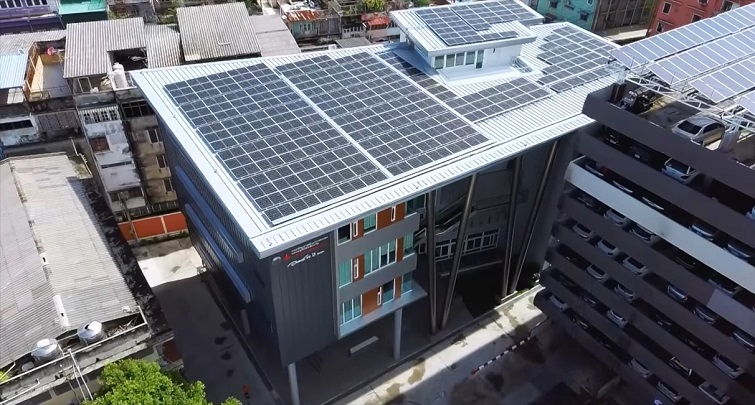2024 Country Update
National PV Policy
Thailand continued its roadmap to achieve carbon neutrality by 2050 and net zero emissions by 2065. In terms of power production, our National Energy Plan (NEP) has set the target to achieve at least 50% of new power generation from renewable sources.
The Ministry of Energy has undergone a public hearing for all sub-plans of the NEP, which consist of the Power Development Plan (PDP), Alternative Energy Development Plan (AEDP), Energy Efficiency Plan (EEP), Gas Plan, and Oil Plan.
According to the draft AEDP 2024, which sets the target of a 37% share of renewable energy in total final energy consumption by 2037, the target for solar power installation capacity is set to achieve 38 974 MWp, and the floating solar target, hybridised with hydropower plants, is set at 2 789 MWp.
Additionally, a 10-year Clean Electricity Production Increment Plan (2021–2030) (Rev.2) was implemented in the PDP 2018 (Rev.1) and set the target for PV installation capacity at 7 087 MW by 2030:
- 5 GW solar ground-mounted, FiT of ~2.17bTHB/kWh
- 1 GW solar ground-mounted with BESS, FiT of ~2.83 THB/kWh
- 997 MW floating solar hybrid with hydropower
- 90 MW solar rooftop for the household sector, FiT of 2.20 THB/kWh
As of 2023, Thailand’s cumulative installed PV capacity reached 5 034 MWp, consisting of 3n154cMWp solar ground-mounted, 1 775 MWp solar rooftop, 92 MWp floating solar, and 13 MW off-grid solar systems.
Apart from the aforementioned FiT programme for solar PV, Thailand has implemented a number of supportive measures:
- Utility Green Tariff (UGT) to facilitate the provision of green electricity for stakeholders/private sectors necessary for their routine services and manufacturing. There are two types of UGT – UGT-1 (non-specified power source) and UGT-2 (specified power source), both expected to be implemented by 2025.
- Direct Power Purchase Agreement (Direct PPA) to allow direct purchase of renewable electricity to attract large foreign investments, e.g., data centres in Thailand. This measure is being studied by the Energy Policy and Planning Office and the Office of Energy Regulatory Commission.
- BOI tax incentives continue to provide support for projects with solar energy installations – i.e., corporate income tax exemptions/deductions.
- Solar rooftop promotion programmes for both government buildings and the household sector are being considered for future implementation. The latter will be implemented via a tax-incentive mechanism.
Thailand is introducing a number of supportive measures, such as the Utility Green Tariff (UGT) and the Direct Power Purchase Agreement (Direct PPA), to enhance the readiness and competitiveness of domestic PV-related stakeholders and to explore new opportunities in global markets.
Research, Development and Demonstration
New solar cell materials were being studied by many academic institutes. For example, Chiang Mai University developed a carbon electrode replacement for rare or valuable elements in thin-film perovskite solar cell research.
The power conversion efficiency was shown to increase to around 11%, with over two years of stability without encapsulation. A reduction in production costs was expected to reach around 27%.
Mahidol University was also interested in developing the perovskite fabrication process by using a novel solvent type to increase efficiency and enhance the environmental friendliness of perovskite cell production processes.
Moreover, alternatives to lithium-ion batteries were also being researched in Thailand. For example, Khon Kaen University was conducting a study on electrode replacements derived from rice husks and solar cell waste. The new nano-silicon-based material had shown a 15% increase in electrical capacity. It was expected to reduce raw material imports and promote the circular economy.
Industry and Market Development
Thailand’s PV industry and market continued its expansion in 2024, driven by policy support, increasing awareness of self-consumption and energy savings, growing manufacturing capacity, and rising export demand.
In 2024, there were 14 PV cell and module manufacturers in Thailand (up from 10 in 2023), with machine production capacity of up to 10 GW per year. Among these, six were domestic manufacturers. Moreover, six inverter manufacturers and three Li-ion battery manufacturers were present in Thailand.
Export activity remained a key driver, with PV panel exports valued at approximately $3 billion and PV cell exports at $1.3 billion as of June 2024.
In 2024, the price of PV modules in Thailand ranged between $0.10–$0.40 USD/Wp (slightly decreased from the previous year), while installation costs for PV systems in the residential, commercial, and industrial sectors also saw slight decreases, as follows:
- Residential: 74–1.03 USD/Wp
- Commercial: 65–0.74 USD/Wp
- Industrial: 59–0.68 USD/Wp
In 2024, a data acquisition revision was conducted for 2022 and 2023, revealing that the installed capacity was 4.5 GWp in 2022 and 5.0 GWp in 2023.
Participants
Department of Alternative Energy Development and Efficiency
Charuwan PHIPATANA-PHUTTAPANTA
Nantika THANGSUPHANICH
POONKASEM Patthamaporn
Ratree KHAISIL
Task - 1
Department of Alternative Energy Development and Efficiency
Charuwan PHIPATANA-PHUTTAPANTA
PACHITTYEN Watcharin
SAWAI Thidarat
SOIKAEW Arkorn
SOMPRANON Munika
Task - 13
King Mongkut University of Technology Thonbury, CES Solar Cells Testing Center (CSSC)
